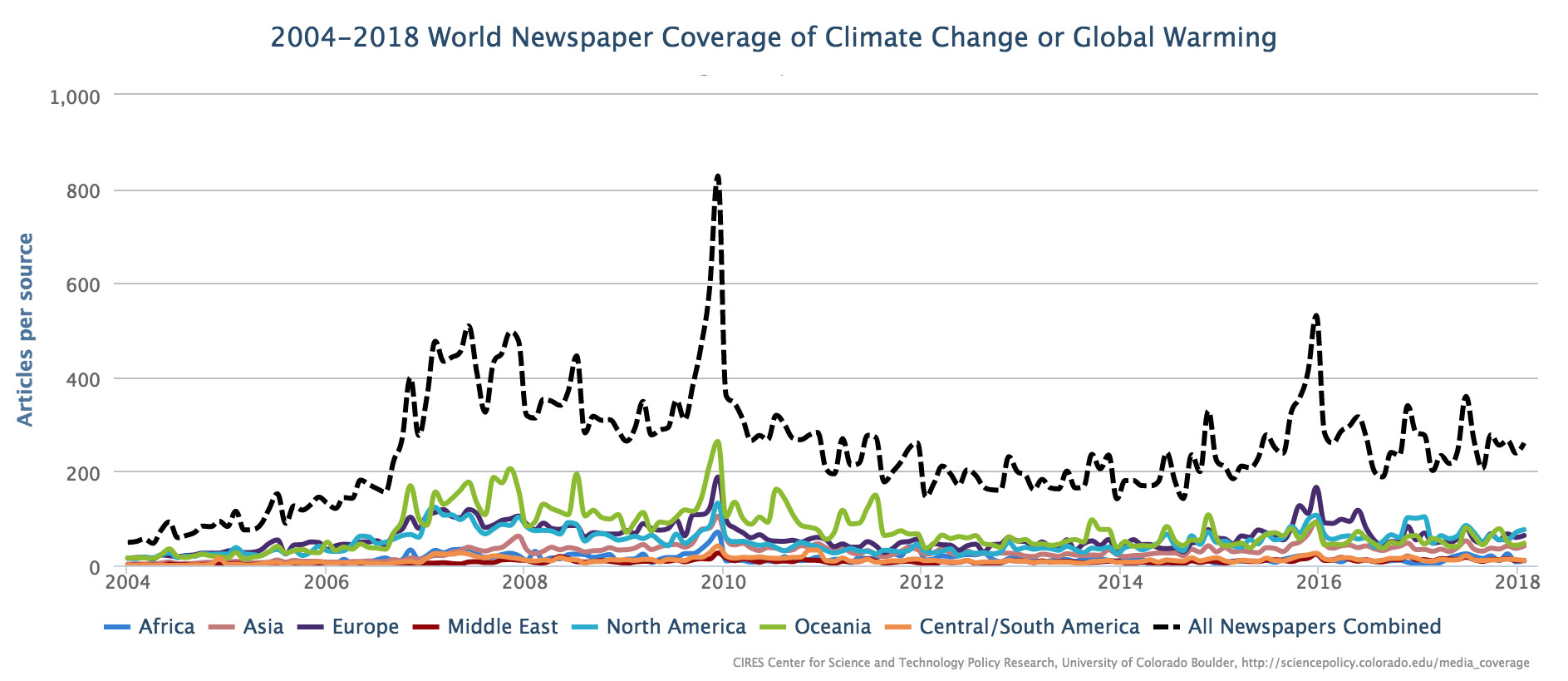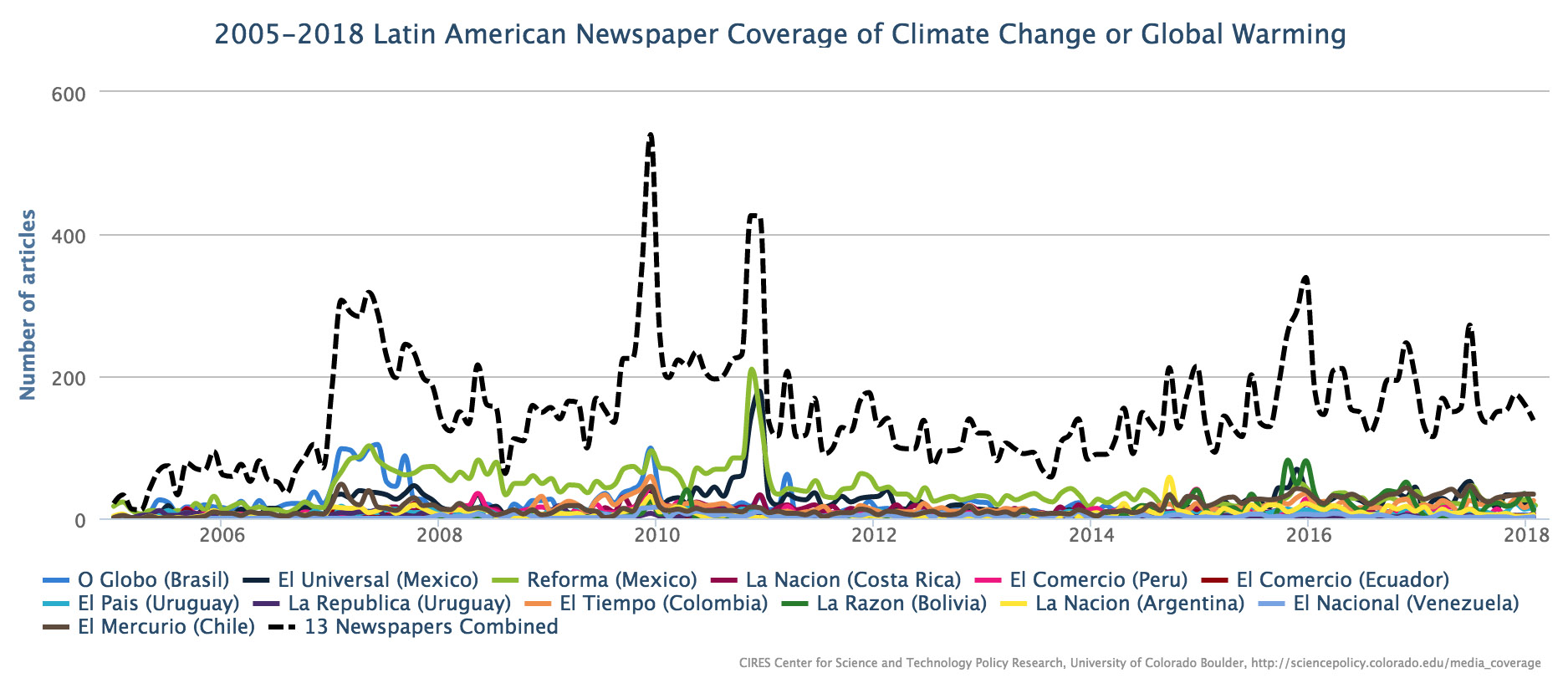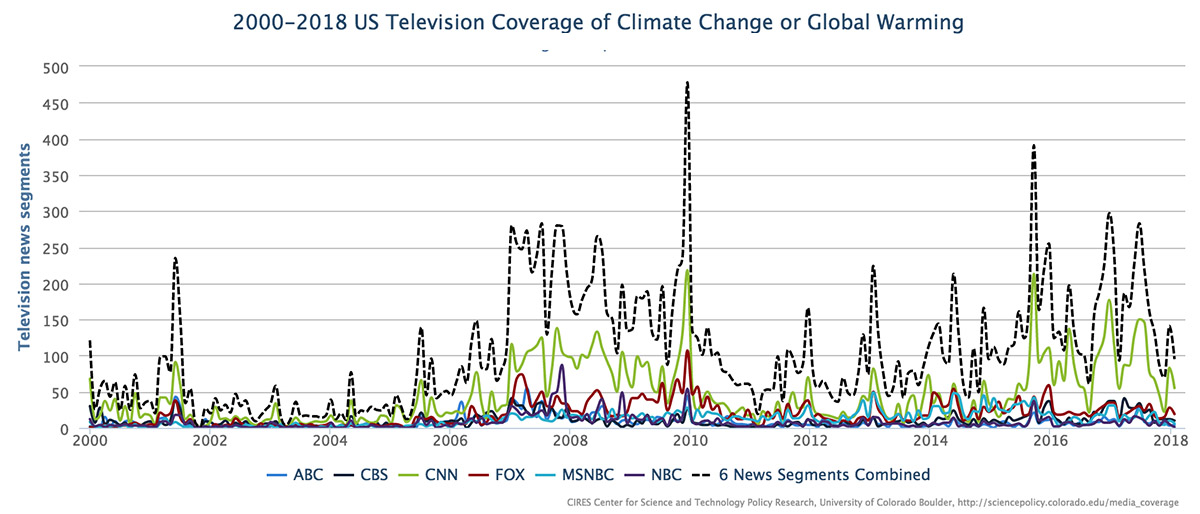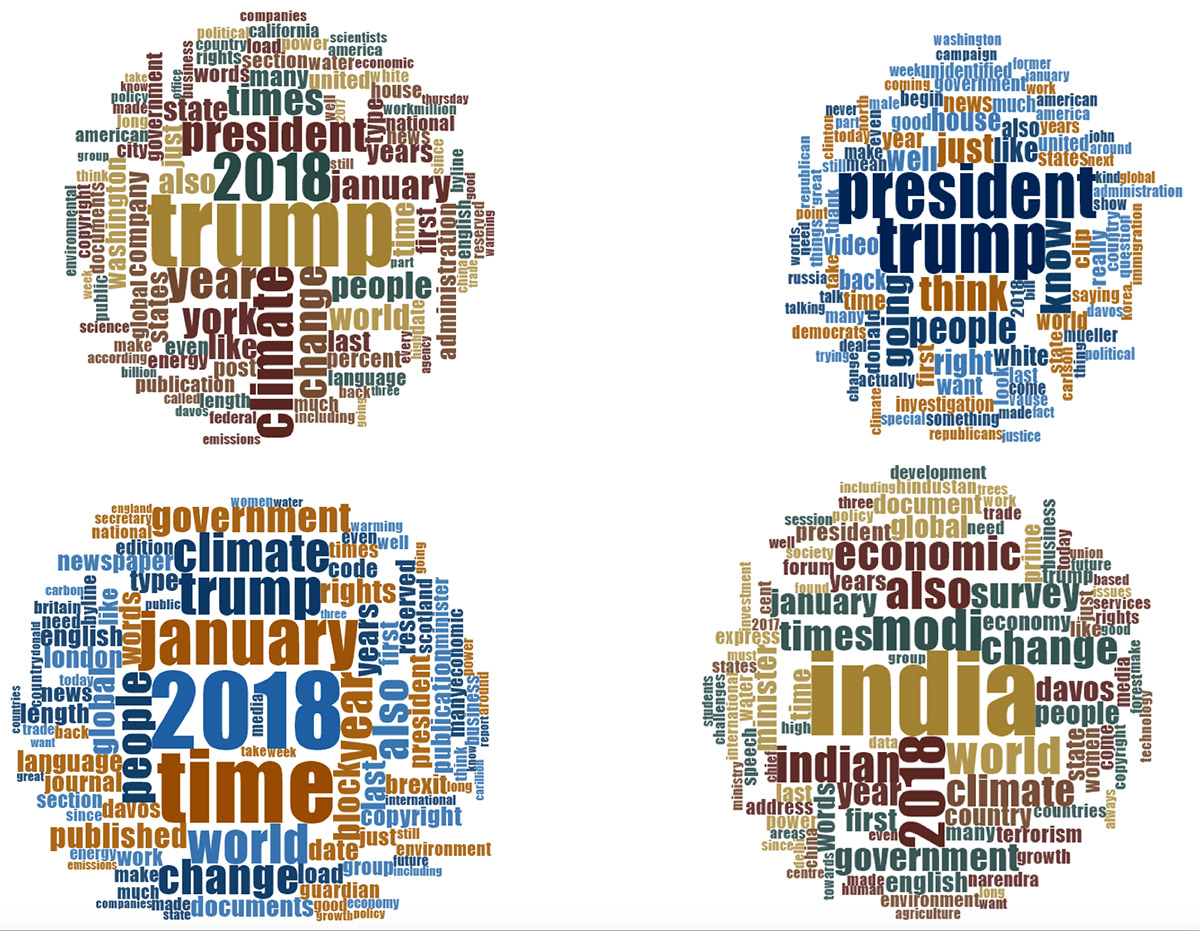Monthly Summaries
Issue 13, January 2018
[DOI]
January media attention to climate change and global warming was up 8% throughout the world from the previous month of December 2017. Increases were detected in Asia (up 15%), Africa (up 43%) Europe (up 7%), Oceania (up 11%), and North America (up 9%), while holding relatively steady in the Middle East. The Media and Climate Change Observatory (MeCCO) detected a decrease in coverage in Central/South America (down 14%). However, the global numbers were down about 5% from counts a year ago (January 2017). The high levels of coverage in January 2017 were largely attributed to the discussions of possible climate change and global warming policy stances after the inauguration of United States (US) President Donald J. Trump. At the country level, coverage went up from the previous month in Australia (+25%), India (+16%), Spain (+7%), the United Kingdom (UK) (+8%), and the United States (+13%), while it went down in Canada (-5%), Germany (-28%), and New Zealand (-13%).
Figure 1 shows these ebbs and flows in media coverage at the global scale - organized into seven geographical regions around the world - from January 2004 through January 2018.

Figure 1. Newspaper media coverage of climate change or global warming in sixty-two sources across thirty-five countries in seven different regions around the world, from January 2004 through January 2018.
This month MeCCO expanded coverage to sixty-two newspaper sources across thirty-five countries, adding sources in Latin America. We have strengthened our Spanish-language searches for articles with the presence of terms "cambio climático" or "calentamiento global", while we expanded our searches now to Portuguese through searches for the terms "mudanças climáticas" or "aquecimento global". Figure 2 shows Latin American newspaper coverage from January 2005 through January 2018.

Figure 2. Newspaper media coverage of climate change or global warming in thirteen Latin American sources eleven countries, from January 2005 through January 2018. The sources are El Universal (México), Reforma (México), La Nación (Costa Rica), El Comercio (Perú), El Comercio (Ecuador), El País (Uruguay), La República (Uruguay), El Tiempo (Colombia), La Razón (Bolivia) O'Globo (Brasil), La Nación (Argentina), El Nacional (Venezuela), and El Mercurio (Chile).
Also new to MeCCO is monitoring of climate change or global warming in US television coverage from January 2000 through January 2018. We now monitor ABC, CBS, CNN, Fox News Network, MSNBC, and NBC.

Figure 3. US television media coverage of climate change or global warming in six sources from January 2000 through January 2018. The sources are ABC, CBS, CNN, Fox News Network, MSNBC, and NBC.
Moving to considerations of content within these searches, Figure 4 shows word frequency data at the country levels in US newspapers, US television, UK newspapers, and Indian newspapers in January 2018.
The five representative US sources showed continuing signs of a 'Trump Dump' (where media attention that would have focused on other climate-related events and issues instead was placed on Trump-related actions (leaving many other stories untold)). This pattern of news reporting continued to be limited to the US context. For instance, in January US news articles related to climate change or global warming, Trump was invoked 4145 times through the 472 stories this month (a ratio of 8.8 times per article on average) in The Washington Post, The Wall Street Journal, The New York Times, USA Today, and the Los Angeles Times. In US television sources of ABC, CBS, CNN, Fox News Network, MSNBC, and NBC, Trump was mentioned 4108 times through just 95 news segments (43 mentions per segment). However, in contrast in the UK press, Trump was mentioned in the Daily Mail & Mail on Sunday, Guardian & the Observer, the Sun, the Daily Telegraph & Sunday Telegraph, the Daily Mirror & Sunday Mirror, the Scotsman & Scotland on Sunday, and the Times & Sunday Times 1265 times in 589 January articles (approximately 2.1 mentions per article on average). In the Indian press (Indian Express, The Hindu, Hindustan Times, and Times of India), Trump was mentioned just 75 times in 353 articles in January (approximately 0.2 times per article on average).

Figure 4. Word clouds showing frequency of words (4 letters or more) invoked in media coverage of climate change or global warming in US newspapers (top left), and US television (top right), the United Kingdom newspapers (bottom left), and Indian newspapers (bottom right) in January 2018.
The US-based Trump Dump can be illustrated through a remarkable Washington Post opinion from the Editorial Board on January 20, entitled 'The shutdown brouhaha has covered up far bigger news'. Noting that 2017 was determined by the National Oceanic and Atmospheric Administration (NOAA) and the National Aeronautics and Space Administration (NASA) to be one of the warmest years on record, they wrote, “One byproduct of the day-to-day chaos of the Trump presidency is that the nation’s biggest, long-term challenges are often forgotten. While Washington spent this week agonizing over the prospect of a totally unnecessary government shutdown, what should have been far bigger news went nearly unremarked.” They went on to boldly write, “Last year also marked a recent low in the federal government’s response to climate change. President Trump installed a climate-change denier, Scott Pruitt, at the Environmental Protection Agency, signaling the end of landmark climate rules on power companies. Mr. Trump’s energy secretary, Rick Perry, pushed for a pro-coal policy so absurd that the independent Federal Energy Regulatory Commission (FERC) rejected it out of hand. The president also announced he would pull out of the Paris climate agreement, an accord that the United States spent years fine-tuning to ensure it was a fair deal.”
These stories were examples of attention paid primarily to political content of coverage during the month. In this space, China continued in its path to take up a leadership position on decarbonization in the void left by the United States. Journalist Hiroko Tabuchi of The New York Times reported that China continued to cut its greenhouse gas emissions by banning the ongoing production of over 500 car models - from both foreign and domestic companies - that don’t meet new Chinese fuel economy standards. Also, preceding the World Economic Forum (WEF) in Davos, where climate change was a much discussed topic by all world leaders besides US President Donald Trump, the WEF Global Risks Report - a survey of 1,000 international business, government, education and service leaders - was released. Reporter Kim Hjelmgaard from USA Today wrote "Mother Nature topped the most significant risks facing the world for a second year in a row... that includes natural disasters and extreme weather events that human-caused climate change may be abetting".
Across the globe in January there were a range of stories that intersected with the cultural arena. For example, at the end of January the Doomsday Clock was advanced closer to midnight due primarily to concerns of climate change and nuclear war. Journalist Doyle Rice from USA Today quoted Rachel Bronson, president of the Bulletin of the Atomic Scientists, who said "Because of the extraordinary danger of the current moment, [we] move the minute hand of the Doomsday Clock thirty seconds closer to catastrophe. This is the closest the Clock has ever been to Doomsday, and as close as it was in 1953 at the height of the Cold War".
Intersecting political and cultural dimensions, coal was anthropomorphized and championed throughout the month in media accounts, mainly focused on actions in the US Trump Administration. While market forces (e.g. competition with natural gas and renewables) work against coal, numerous media reports mentioned coal mine closings. For example, the Associated Press reported on 400 jobs lost at a Pennsylvania coal mine closing announcement in early January. Yet as part of the FERC rebuff of a pro-coal policy put forward in mid-January (mentioned in the Washington Post editorial above), journalist Joanna Walters from The Guardian wrote that the decision was “a blow to the president’s high-profile mission to revive the struggling US coal industry”. The end the month, Kenneth Vogel and Rachel Shorey in The New York Times outlined shadowy carbon-based industry donations to the Trump Administration that may help explain these against-the-grain pro-coal stances. Nonetheless, in the US State of the Union address by the President on January 30, Trump championed “beautiful and clean coal” in energy priorities going forward in 2018, despite some factual challenges mentioned by the editorial team in The Australian.
In January, coverage relating primarily to ecological and meteorological issues garnered attention. There were a number of stories about extreme weather events around the world. For example, a 'bomb cyclone' in the Northeast began the month. Also, James Queally, Melissa Etehad, and Brittny Mejia reported in the Los Angeles Times on how the southern California mudslides related to preceding wildfires and flood events across the state.
Media accounts also focused on primarily scientific dimensions of climate change and global warming. The most media attention in the month focused on the temperature records set in 2017. For example, journalist Damian Carrington at The Guardian was one of many reporters and outlets that covered news that 2017 was the warmest year on record without an El Niño, and the third warmest year after 2016 and 2015.
Onward we go into 2018.
